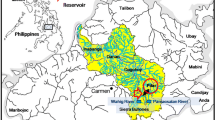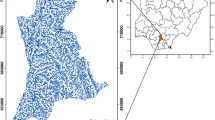Abstract
The estimation of soil erosion rates in complex subtropical agricultural systems of hilly environment is difficult and most of the traditional methods have serious limitations. The 137Cs technique allows to obtain relatively quickly retrospective medium term soil erosion results. The objective of this study was using 137Cs approach to quantify soil loss under agricultural system which develops under growing human pressure on the hilly terrain of the Meghalaya Plateau. The measured values of caesium inventory for all sampling points are between 2% and 63% of the reference value of caesium inventory. The estimated annual soil loss for sampling points located on the slope are between 29 and 79 Mg·ha−1·yr−1 in the case of an improved mass balance model. It means that soil erosion in this manually tilled agricultural area cannot be neglected.
Similar content being viewed by others
Rferences
Census of India, 2001. New Delhi: 138 pp.
Collins AL, Walling DE, Sichingabula HM and Leeks GJL, 2001. Using 137Cs measurements to quantify soil erosion and redistribution rates for areas under different land use in the Upper Kaleya River basin, southern Zambia. Geoderma 104(3–4): 299–323, DOI 10.1016/S0016-7061(01)00087-8.
Dupin B, de Rouwb A, Phantahvong KB and Valentin C, 2009. Assessment of tillage erosion rates on steep slopes in northern Laos. Soil & Tillage Research 103(1):119–126, DOI 10.1016/j.still.2008.10.005.
El-Swaify SA, 1997. Factors affecting soil erosion hazards and conservation needs for tropical steeplands. Soil Technology 11(1): 3–16, DOI 10.1016/S0933-3630(96)00111-0.
Forsyth TJ, 1994. The use of caesium-137 measurements of soil erosion and farmers perception to indicate land degradation amongst shifting cultivators in northern Thailand. Mountain Research and Development 14: 229–244.
Froehlich W, 2004. Soil erosion, suspended sediment sources and deposition in the Maw-Ki-Syiem drainage basin, Cherrapunji, northeastern India. In: Golosov V, Belyaev V and Walling DE, eds, Sediment Transfer Through The Fluvial System, IAHS Publication, 288: 138–146.
Kimaro DN, Deckert JA, Poesen J, Kilasarad M, Msanya BM, 2005. Short and medium term assessment of tillage erosion in the Uluguru Mountains, Tanzania. Soil & Tillage Research 81(1): 97–108, DOI 10.1016/j.still.2004.05.006.
Lu XX and Higgitt DL, 2000. Estimating erosion rates on sloping agricultural land in the Yangtze Three Gorges, China, from caesium-137 measurements. Catena 39(1): 33–51, DOI 10.1016/S0341-8162(99)00081-8.
Mishra BK and Ramakrishnan PS, 1983. Slash and burn agriculture at higher elevations in north-eastern India. I. Sediment, water and nutrient losses. Agriculture, Ecosystems and Environment 9(1): 69–82, DOI 10.1016/0167-8809(83)90007-5.
Murata F, Hayashi T, Matsumoto J and Asada H, 2007. Rainfall on the Meghalaya plateau in northeastern India — one of the rainiest places in the world. Natural Hazards 42(2): 391–399, DOI 10.1007/s11069-006-9084-z.
Nagle GN, Lassoie JP, Fahey TJ and McIntyre SC, 2000. The use of caesium-137 to estimate agricultural erosion on steep slopes in a tropical watershed. Hydrological Processes 14: 957–969.
Neergaard de A, Magid J and Mertz O, 2008. Soil erosion from shifting cultivation and other smallholder land use in Sarawak, Malaysia, Agriculture, Ecosystems and Environment 125(1–4): 182–190, DOI 10.1016/j.agee.2007.12.013.
Prokop P, 2005. Natural hazards and anthropogenic impact on environment in a tropical mountain catchment, Meghalaya Hills, India. Studia Geomorphologica Carpatho-Balcanica 39: 95–113.
Prokop P and Walanus A, 2003. Trend and periodicity in the longest instrumental rainfall series for the area of most extreme rainfall in the world, northeast India. Geographia Polonica 76(2): 25–35.
Poreba G, 2006. Caesium-137 as a soil erosion tracer: a review. Geochronometria 25: 37–46.
Poręba G and Bluszcz A, 2007. Determination of the initial 137Cs fallout on the areas contaminated by Chernobyl fallout. Geochronometria 26: 35–38, DOI 10.2478/v10003-007-0009-y.
Poręba G and Bluszcz A, 2008. Influence of the parameters of models used to calculate soil erosion based on 137Cs tracer. Geochronometria 32: 21–27, DOI 10.2478/v10003-008-0026-5.
Ramakrishnan PS, 1992. Shifting Agriculture and Sustainable Development: An Interdisciplinary Study from North-Eastern India. UNESCO-MAB Series, Parthenon Publications, Paris 422 pp.
Ritchie J and McHenry J, 1990. Application of radioactive fallout caesium-137 for measuring soil erosion and sediment accumulation rates and patterns: a review. Journal of Environmental Quality 19(2): 215–233, DOI 10.2134/jeq1990.00472425001900020006x.
Sarmiento J and Gwinn E, 1986. Strontium 90 fallout prediction. Journal of Geophysical Research 91(C6): 7631–4646, DOI 10.1029/JC091iC06p07631.
Singh G, Babu R and Chandra S, 1981. Soil Loss Predictions in India, CS&WCRTI, Bulletin No 12/D9, Dehra Dun India: 70 pp.
Singh RS, 2005. Soil Series of Meghalaya. Technical Bulletin, NBSS&LUP, Nagpur: 121pp.
Soja R and Starkel L, 2007. Extreme rainfalls in Eastern Himalaya and southern slope of Meghalaya Plateau and their geomorphologic impacts. Geomorphology 84(3–4):170–180, DOI 10.1016/j.geomorph.2006.01.040.
Starkel L and Singh S, eds., 2004. Rainfall, runoff and soil erosion in the globally extreme humid area, Cherrapunji region, India. Prace Geograficzne 191: 110 pp.
Tiwari B K, 2003, Innovations in shifting cultivation and land use and cover change in higher elevations of Meghalaya, India. In: Ramakrishnan PS, Saxena KG, Patnaik S and Singh S, eds, Methodological issues in mountain research. A socio-ecological system approach observations, UNESCO, MAB, ICIMOD, NEHU, New Delhi, Oxford and IBH Publishing Co. Pvt. Ltd.: 163–175.
Walling DE, and He Q, 1999. Improved models for estimating soil erosion rates from caesium-137 measurements. Journal of Environmental Quality 28(2): 611–622, DOI 10.2134/jeq1999.00472425002800020027x.
Zapata F, 2003. The use of environmental radionuclides as tracers in soil erosion and sedimentation investigations: recent advances and future developments. Soil & Tillage Research 69(1–2): 3–13, DOI 10.1016/S0167-1987(02)00124-1.
Zhang JH, Lobb DA, Li Y and Liu GC, 2004. Assessment of tillage translocation and tillage erosion by hoeing on the steep land in hilly areas of Sichuan, China. Soil and Tillage Research 75(2): 99–107, DOI 10.1016/j.still.2003.08.003.
Author information
Authors and Affiliations
Corresponding author
About this article
Cite this article
Poręba, G.J., Prokop, P. Estimation of soil erosion on cultivated fields on the hilly Meghalaya Plateau, North-East India. Geochron 38, 77–84 (2011). https://doi.org/10.2478/s13386-011-0008-7
Received:
Accepted:
Published:
Issue Date:
DOI: https://doi.org/10.2478/s13386-011-0008-7




